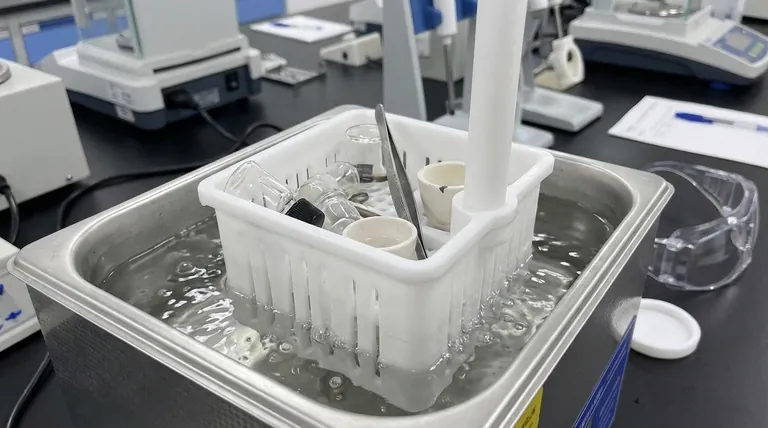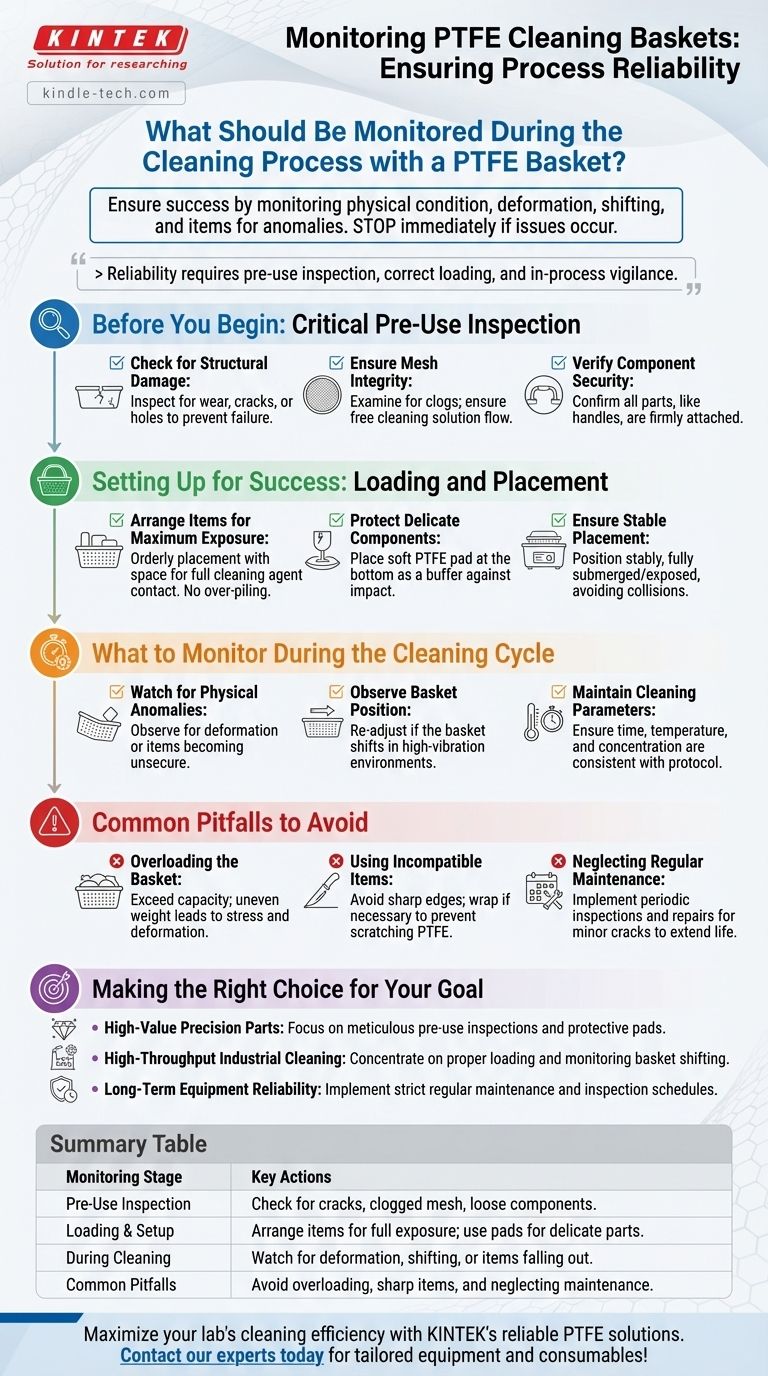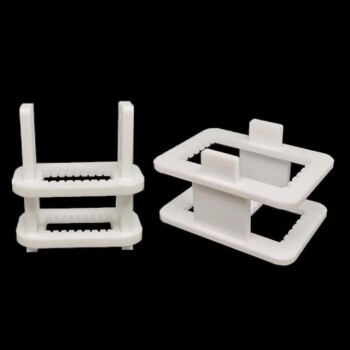To ensure a successful cleaning process, you must monitor the physical condition of the PTFE basket and the items within it for any anomalies. This includes watching for basket deformation, shifting positions (especially during ultrasonic cleaning), or any signs that the items are falling out. If any of these issues occur, the process must be stopped immediately for correction.
The reliability of a cleaning process using a PTFE basket extends beyond the cycle itself. It requires a systematic approach encompassing pre-use inspection, correct loading, and in-process vigilance to prevent part damage and ensure consistent, effective results.

Before You Begin: The Critical Pre-Use Inspection
The integrity of your entire cleaning process starts with a healthy basket. A quick check before each use can prevent costly failures.
Check for Structural Damage
Carefully inspect the basket for any signs of wear and tear, such as cracks or holes. A compromised structure can fail mid-process, potentially damaging valuable components.
Ensure Mesh Integrity
Examine the mesh to ensure it is not clogged with residue from previous cycles. Clogged mesh can impede the flow of the cleaning solution and compromise cleaning effectiveness.
Verify Component Security
Confirm that all parts of the basket, such as the handle, are securely attached. A loose component could detach during cleaning, disrupting the process.
Setting Up for Success: Loading and Placement
How you load and position the basket is just as important as the cleaning parameters themselves. Proper setup guarantees optimal exposure to the cleaning agent.
Arrange Items for Maximum Exposure
Place items in an orderly fashion, leaving sufficient space between them. This allows the cleaning solution to make full and even contact with all surfaces. Avoid over-piling.
Protect Delicate Components
For fragile or precision parts, place a soft PTFE pad at the bottom of the basket. This simple step provides a crucial buffer against impact damage during the cleaning cycle.
Ensure Stable Placement in Equipment
Position the basket stably inside the cleaning equipment, such as an ultrasonic cleaner. Ensure it is either fully submerged or fully exposed to the spray, depending on your method, and avoid forceful collisions with the equipment walls.
What to Monitor During the Cleaning Cycle
Vigilance during the cleaning process allows you to catch and correct issues before they compromise the outcome.
Watch for Physical Anomalies
Closely observe the basket for any signs of deformation. Also, ensure that the items remain securely within the basket throughout the cycle.
Observe Basket Position
In high-vibration environments like ultrasonic cleaning, baskets can shift. If you notice the basket has moved, it should be readjusted to maintain cleaning efficacy.
Maintain Cleaning Parameters
While observing the basket, always ensure the established cleaning parameters—such as time, temperature, and solution concentration—are being maintained as required by your protocol.
Common Pitfalls to Avoid
Understanding the limitations and common failure points of PTFE baskets is key to extending their life and ensuring process reliability.
Overloading the Basket
Never exceed the basket's specified maximum load capacity. Distribute the weight of the items evenly to avoid creating localized stress that can lead to deformation.
Using Incompatible Items
Avoid placing items with sharp edges or corners directly into the basket. If necessary, wrap them in a soft material first to prevent scratching or puncturing the PTFE surface.
Neglecting Regular Maintenance
Implement a schedule for periodic inspections, such as monthly checks. If minor cracks are found, they can often be repaired with a specialized PTFE repair agent, extending the basket's service life.
Making the Right Choice for Your Goal
Your monitoring strategy should align with the specific demands of your cleaning application.
- If your primary focus is cleaning high-value precision parts: Prioritize meticulous pre-use inspections and the use of protective PTFE pads to prevent any possibility of damage.
- If your primary focus is high-throughput industrial cleaning: Concentrate on proper loading to avoid overloading and closely monitor for basket shifting during the cycle.
- If your primary focus is ensuring long-term equipment reliability: Implement a strict regular maintenance and inspection schedule to catch and repair minor damage before it leads to failure.
A systematic approach to handling and monitoring transforms a simple basket into a highly reliable tool for your critical cleaning operations.
Summary Table:
| Monitoring Stage | Key Actions |
|---|---|
| Pre-Use Inspection | Check for cracks, clogged mesh, and loose components. |
| Loading & Setup | Arrange items for full exposure; use pads for delicate parts. |
| During Cleaning | Watch for deformation, shifting, or items falling out. |
| Common Pitfalls | Avoid overloading, sharp items, and neglecting maintenance. |
Maximize your lab's cleaning efficiency and protect valuable components with KINTEK's reliable PTFE solutions. Our PTFE cleaning baskets are designed for durability and precision, ensuring consistent results for your high-value or high-throughput applications. Contact our experts today to find the perfect lab equipment and consumables tailored to your specific needs!
Visual Guide

Related Products
- Custom PTFE Teflon Parts Manufacturer Corrosion Resistant Cleaning Rack Flower Basket
- Custom PTFE Teflon Parts Manufacturer for Hollow Cleaning Basket and Rack Carrier
- Custom Machined and Molded PTFE Teflon Parts Manufacturer for Laboratory ITO FTO Conductive Glass Cleaning Flower Basket
- Custom PTFE Teflon Parts Manufacturer for Conductive Glass Substrate Cleaning Rack
- Custom PTFE Teflon Parts Manufacturer for Centrifuge Tube Racks
People Also Ask
- What inspection should be performed on a PTFE cleaning basket before use? A 3-Step Protocol for Safe, Effective Cleaning
- What is the maximum operating temperature for a PTFE cleaning basket? Avoid Catastrophic Failure at 260°C
- What are the common specifications and shapes for PTFE cleaning baskets? Maximize Chemical Purity & Process Integrity
- How should a PTFE cleaning basket be cleaned before its initial use? A Critical First Step for Process Integrity
- How should a PTFE cleaning basket be stored when not in use? Maximize Lifespan & Prevent Contamination



















